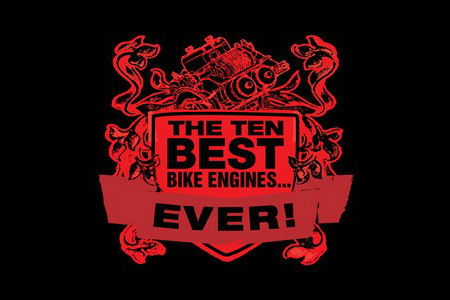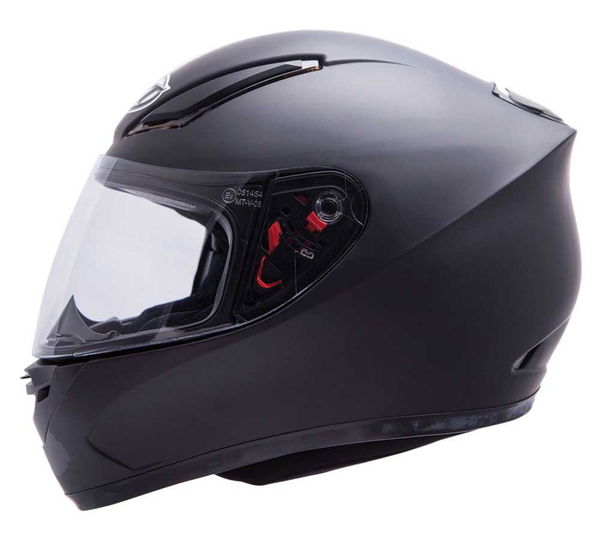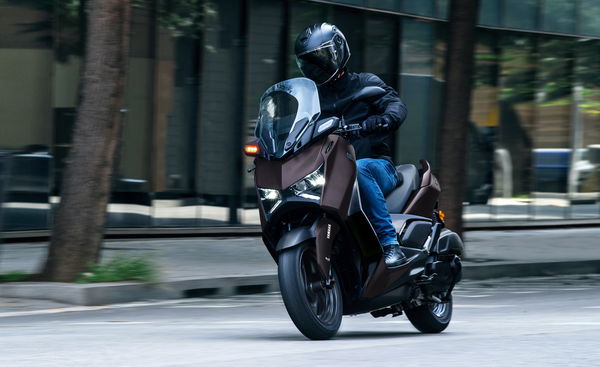Top 10 best motorcycle engines ever
Visordown’s top 10 most important motorcycle engines of all time

IF a motorcycle were a meal, the engine would be the flavour.
It’s where it gets its character, what some might call its soul, and there are so many delicious varieties, from peaky two-strokes to window-rattling V-twins.
Some stand out as extraordinary, perhaps because they were ground-breaking, perhaps for their influence on later designs, or perhaps because they’re powerful enough to make time go backwards.
Here are the 10 that we think are probably the most important ever made.
1. DUCATI 851
Year: 1988
Power: 93hp @ 9,00rpm
Torque: 63lbft @ 7,500rpm
Lay out: 851cc 8-valve 90° V-twin
If ever a bike deserved to be named simply after its engine, it’s the 851. The unusual capacity wasn’t important; the layout certainly was. Chief engineer Massimo Bordi’s fuel-injected, liquid-cooled, eight-valve V-twin power plant brought Ducati’s desmodromic V-twin thundering into the modern era. It was a huge leap forward in performance.
If updating the traditional air-cooled, SOHC V-twin in that way seemed an obvious step, no less an authority than Fabio Taglioni, Bordi’s legendary predecessor, had previously dismissed the idea. It was left to Bordi, who had designed a four-valve desmo motor for his thesis while studying engineering at Bologna University, to develop the new cylinder head design, in collaboration with Cosworth.
The 851 was an immediate hit on its introduction in 1988. The liquid-cooled motor produced 93hp with strong mid-range, and was far more sophisticated than Ducati’s air-cooled V-twin. In 1990 the race bike ridden by Frenchman Raymond Roche won Ducati’s first World Superbike title.
The ‘90s saw the eight-valve motor enlarged first to 888cc, then again to fire the magical 916. Ducati’s Hypersport line has since seen capacity grow to 1198cc, gaining redesigned Testastretta heads and countless other mods along the way. The liquid-cooled lump has served in bikes ranging from Monsters to the ST4 sports-tourers, and none of this would have been possible without this original 851 motor. Ducati’s debt to Bordi’s masterpiece continues to grow, two decades and 13 World Superbike titles after its launch.
2. HONDA CB750
Power: 68hp @ 8,000rpm
Torque: 49lbft @ 6,900rpm
Lay out: 736cc, SOHC, parallel-four
Motorcycling was transformed forever when Honda introduced the world’s first mass-produced four-cylinder engine in 1969. Compared to the twins that had gone before, and even to the Triumph T150 Trident triple that arrived in the same year, the CB750 was a creature from a different planet. Multi-cylinder motorcycling had arrived.
By far the Honda’s most important feature was that 736cc power plant, the most glamorous and sophisticated yet seen. It featured a single overhead cam and two valves per cylinder, so wasn’t high-tech by Honda’s own standards. Soichiro’s firm had built higher-revving multi-cylinder race bikes with twin cams and four valves per pot. But its max of 67bhp at 8,000rpm gave a top speed of 120mph - faster than just about anything else on the road - and the Honda got there mighty quickly. The world had (quite literally) never seen anything like it.
It was its sophistication, even more than pure performance, that earned the CB750 the title of world’s first superbike. That motor was smooth, quiet, oil-tight and reliable. It incorporated an electric starter and a five-speed gearbox, and came with four shiny exhaust silencers to emphasise the number of pots.
By contrast there wasn’t much that was special about the CB750’s chassis, apart from its disc front brake. The engine’s power sometimes overwhelmed its simple steel frame and suspension; many old-style twins handled better. Honda moved slowly to update the four, taking a decade before introducing a DOHC cylinder head on the CB750K.
But that brilliant engine made the first CB750 a huge success, and the one of the most influential motorcycles ever built. If it wasn’t for this engine, none of the others would have come...
3. YAMAHA R1
Year: 1998
Power: 150hp @ 11,700Rrpm
Torque: 72lbft @ 9,100rpm
Lay out: 998cc, DOHC, parallel-four
Sharp styling, light weight and ace handling contributed to the impact that Yamaha’s YZF-R1 made at its launch in 1998, raising the super-sports bar in a way not seen since Honda’s FireBlade six years earlier. But whereas the Honda’s engine had been secondary to its light and agile chassis, the Yam’s 998cc four-pot powerplant was the star attraction.
The R1 was famous for three things: weight, wheelbase and power, with the emphasis on the latter. It wasn’t just the way the engine screamed to its 11,750rpm limit that made the Yam so exhilarating. The 20-valve unit, with a basic layout dating back to the 1985 FZ750, also provided crisp carburation and fierce mid-range heft.
Project leader Kunihiko Miwa’s creation gained more from its motor than straight-line speed, too. The R1’s stacked gearbox location, behind the cylinders, meant the powerplant could be notably compact, allowing a long swing-arm for added stability. This arrangement is now copied by nearly all the Japanese manufacturers. The similarly innovative one-piece cylinder and crankcase assembly was more rigid than conventional designs, allowing the motor to form a stressed member of the chassis, so the Deltabox II frame could be lighter.
The latest crossplane crank iteration has more over-square dimensions and pumps out and a colossal 200hp, but it owes its existence to the unforgettable ’98 original.
4. SUZUKI GSX-R1100
Year: 1986
Power: 125hp @ 8,750rpm
Torque: 62lbft @ 7,800rpm
Lay out: 1052cc DOHC parallel-four
One of the most inspired bikes of the ‘80s was Suzuki’s GSXR750, whose ultra-light, aluminium-framed chassis and unprecedented race-replica aggression took high-performance motorcycling in a radical new direction on its launch in 1985. But probably the decade’s most impressive engine arrived a year later, when Suzuki fitted a strengthened version of the same frame with a 1052cc four-cylinder motor to create the now legendary GSX-R1100.
Like the smaller powerplant, the slab-sided GSX-R was a DOHC 16-valve unit, oil-cooled by Suzuki’s SACS (Suzuki Advanced Cooling System) arrangement of under-piston lube jets and tightly packed cylinder fins. The larger motor had a lower 10:1 compression ratio, used CV instead of slide carbs and was far more flexible. Its peak output of 125hp at 8,500rpm was a gain of 25hp on the 750 but the real advantage was its massively increased mid-range grunt.
That helped make the light and fine-handling GSX-R1100 by far the world’s fastest and best sports bike on its launch in ’86, and its advantage did not end there. In contrast to the fragile 750 motor, the GSXR1100 was so tough that it rapidly became the engine of choice for drag racers and builders of radical specials, many of whom achieved outrageous power with limited modifications. An output of 500hp was achievable.
In 1989 it was enlarged to 1127cc for the GSX-R1100K, which was even more powerful, equally robust and even better suited to tuning, and in 1993 Suzuki finally joined the liquid-cooled masses with the GSX-R1100WP.
The unbreakable oil-cooled Gixxer remains the most memorable. To this day, it’s probably the most infamous big-capacity sports bike engine ever made.
5. HONDA C90
Year: 1958
Power: 7hp @ 3,700rpm
Torque: 4.8lbft @ 2,750rpm
Lay out: 89cc single
It might only be a simple pushrod single, but the motor with which Honda’s C90 and its ancestors changed the face of motorcycling is an epic piece of engineering. The C90 was the UK’s top selling bike as recently as the early Nineties. It was the longest running of a dynasty that dated back to the original Super Cub of 1958.
More than 60 million C90s have been produced, or £50 billion quid’s worth. The big-wheeled step-thru they call the Cub is not just the most successful motorcycle of all time - it’s the most popular vehicle ever created. Fuel-injected variants of it remain in Honda’s line-up in Japan.
At is introduction, Honda’s economic semi-automatic four-stroke engine stood out in a sea of two-strokes. Its location – forward and low like a motorbike, not on the swing-arm like a scooter – aided handling. And you couldn’t kill it, however hard you tried. Thrash it, neglect it, top it up with cooking oil… It just kept coming back for more. Up to 40mph, it was even nippy and fun to ride. With a hoik on the handlebars it could manage a wheelie.
The success of the Super Cub also allowed Honda to invest in more exciting bikes, from Hailwood’s 250-six to the latest Blade.
Ridden alongside modern step-through scooters, the C90 is engaging and with its semi-auto gearbox, teaches people far more about riding. That’s why it remains one the greatest automotive units ever built by anyone, anywhere.
6. KAWASAKI Z1
Year: 1973
Power: 82hp @ 8,500rpm
Torque: 58lbft @ 6,900rpm
Lay out: 903cc, DOHC, parallel-four
You’ve only got to look at the list of the world’s fastest, most exotic hand-built superbikes of the ‘70s to get an idea of the impact made by Kawasaki’s mighty DOHC four-cylinder engine. From Harris, Rickman, and Peckett and McNab in this country, to Bimota, Nico Bakker, Georges Martin and Fritz Egli elsewhere, the specials builders of that era welded their magic around the big Kawa lump.
It’s easy to understand why. When the Z1 was launched in 1973, its 903cc twin-cam engine’s peak output of 82hp at 8,500rpm was 14 horses up Honda’s single-cam CB750. The bigger motor had heaps more mid-range, too. And as a legion of tuners and specials builders were soon to discover, it was durable enough to remain reliable when tuned to over 100hp.
The supremacy of the 130mph standard Z1 and its Z900 successor came about almost by accident. We’ll never know how the motorcycling world of the ‘70s would have panned out had Kawasaki unveiled their 750cc four in 1968, as planned, until they realised they’d been trumped the CB750 and went back to the workshop. The Big K’s engineers enlarged their DOHC powerplant and returned to blow everything else completely out of the water.
The first Zed was a handsome bike, too, but its bendy old chassis had been designed by the B-team. The inevitable high speed shakes led to plenty of work for the specials builders, and inadvertently enhanced a reputation for fearsome fours that Kawasaki enjoys nurturing to this day, most recently with the 310hp track-only Ninja H2R.
7. Honda NSR500
Year: 1992
Power: Over 140hp @ 11,500rpm
Torque: 78lbft
Lay out: 499cc two-stroke, 90° V-four
Honda’s NSR was the most successful of the 500cc two-stroke Grand Prix missiles, and frequently the most scary too. That was mainly due to its V-four engine, which was generally the most powerful on the grid - and sometimes so vicious that the world’s best riders couldn’t control it.
The NSR was debuted in 1984 by Freddie Spencer, who’d won Honda’s first 500cc title the previous year on the sweet-handling NS500 triple. The liquid-cooled V4 was a much nastier device. It differed from Suzuki and Yamaha’s V4s by having a single crankshaft, instead of twin contra-rotating cranks. The reduced friction aided power: the first NSR’s 144hp was pure awesome in 1984.
Fast Freddie won eight out of 12 rounds and the championship in ‘85, and Wayne Gardner followed in ’87, by which time the V4’s breathing had been improved by increasing cylinder angle from 90° to 112°. Eddie Lawson regained the title for Honda in ’89 - after the NSR’s evil-handling chassis had been reinforced mid-season to cope with an engine by now producing over 160hp.
Honda’s V4 ruled the ‘90s, with five titles for Mick Doohan plus one for Alex Criville. Along the way it went to “big-bang” firing order (cylinders firing in quick succession for added traction) then back to “screamer”. In 2000 even Valentino Rossi couldn’t tame an NSR that had been tuned to make almost 200hp. By the time Rossi took the final 500cc crown in 2001, the NSR had won 130 GPs and ten world championships in 18 years. It was the most dominant two-stroke Grand Prix engine ever created, made the MotoGP bikes that replaced it seem utterly bland in comparison, and scarred a lot of brave men in the process. To this day, the NSR500 engine is probably the maddest thing ever made.
8. TRIUMPH DAYTONA 675
Year: 2006
Power: 125hp @ 12,500rpm
Torque: 51lbft @ 10,200rpm
Lay out: 675cc, DOHC, triple
After John Bloor relaunched Triumph in the early ‘90s, it took the firm several years to conclude that what most people wanted from a British manufacturer wasn’t Japanese style four-cylinder bikes, but twins and triples that offered engine character as well as performance. Landmark three-cylinder models included the Speed Triple of 1994, and the similarly distinctive Daytona T595 of three years later.
But the bike that proved Triumph could take the lead in the hardest fought class of all was the Daytona 675. Triumph had been trying to crack the middleweight super-sport division for six years when the triple was launched in 2006. But fours including the TT600 and Daytona 600 had never quite been good enough, and with no other distinguishing features they’d been swamped by the Japanese competition.
The Daytona 675 had several vital advantages. Its 675cc, 12-valve three-cylinder motor not only produced a competitive 125hp, but did so with abundant midrange and a character unique to the class. Good looks and sharp handling helped, but it was the triple motor that did most to earn the Daytona wins in countless magazine comparison tests.
Stripping off the Daytona’s fairing created the unforgettable Street Triple, soon due to become an 800, and the Triumph engine has surely had some influence on decisions by other manufacturers to make triples, such as Yamaha with its MT-09 range.
All of which makes the 675 Triumph a hugely important engine for the UK.
9. HARLEY-DAVIDSON EVOLUTION
Year: 1984
Torque: 78lbft @ 4,000rpm
Lay out: 1340cc OHC 45° V-twin
We know Harley today as massive success story but it hasn’t always been that way. In 1981 the company was save in a management buy-out. And the most important thing those managers did, apart from finding the cash to invest in the failing firm, was develop a new engine for the beleaguered American brand: the Evolution.
Back then, Harley’s main motor was the Shovelhead, which had been introduced in 1966 and had far too much in common with the Knucklehead of three decades earlier. Its performance was feeble, and its reliability so poor that much of the profit from the modest sales was wasted on warranty costs. Harley’s new bosses kept the traditional 45 ° push-rod engine layout, but did a thorough job of updating it. Cylinders were made from aluminium instead of iron. The new 1340cc V-twin also featured redesigned combustion chambers, flat instead of domed pistons, stronger con rods, uprated lubrication and a new electronic ignition. The Evolution engine, as they called it, made 10% more power and 15% more torque. It was smoother, lighter, ran cooler and was far more reliable.
The Evo unit was introduced in seven Harleys in 1984 with dramatic impact, both on performance and warranty claims.
The Evolution’s introduction put Harley’s sales and share price on an upward path that would continue for more than 20 years, making them one of the most successful and sought-after brands in motorcycling history.
10. KAWASAKI H1 500
Year: 1969
Power: 60hp @ 5,500rpm
Torque: 38lbft @ 5,000rpm
Lay out: 498cc air-cooled parallel-triple
There has arguably never been a street bike more dominated by its engine than Kawasaki’s H1 triple of 1969. The 498cc air-cooled two-stroke, also called the Mach III, was created mainly for the stoplight-racing crazy US market, so Kawasaki went all out for power-to-weight ratio. This meant designing the most powerful engine possible, and bolting it into the lightest chassis they could make.
Kawasaki tested twin-cylinder prototype motors before choosing the piston-ported triple, which has potential for more power than a twin because its extra cylinder wall area allows more port area. Young engineer Yukio Otsuki, who headed the project, specified big cooling fins to guard against the middle cylinder overheating, and used an innovative ignition system to allow high revs. The smooth running, 120°crankshaft meant the clutch and gearbox could be notably light.
The H1 motor produced 60hp at 8,000rpm - in a bike whose skinny steel frame and pencil-like forks contributed to a dry weight of just 174kg. The result was a stunning bike that screamed through the quarter in less than 13 seconds at over 100mph, and “trounced any mass production motorcycle regardless of displacement”, according to Cycle World.
The peaky motor came alive at 5,500rpm with a mighty kick and the H1’s high bars and 57% rearwards weight bias made it probably the world’s first production street bike with a barely controllable urge to wheelie. Predictably scary handling added to the excitement. The Mach III cost a dollar under $1,000 in the States in ’69, and was a huge hit that put Kawasaki firmly on the map.
That Kawasaki chose to borrow from its reputation in naming the mighty Ninja H2 is testament to its importance.











